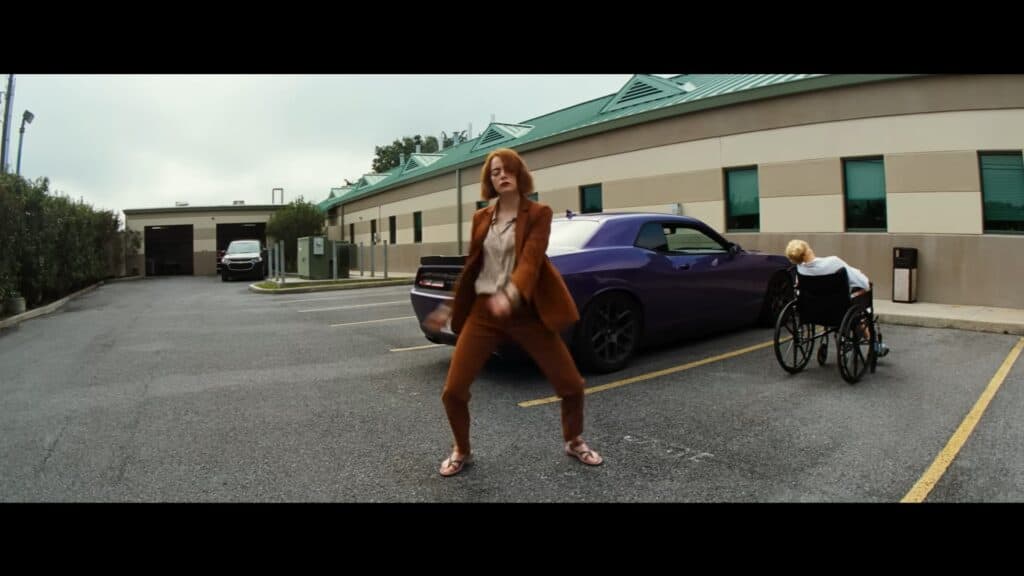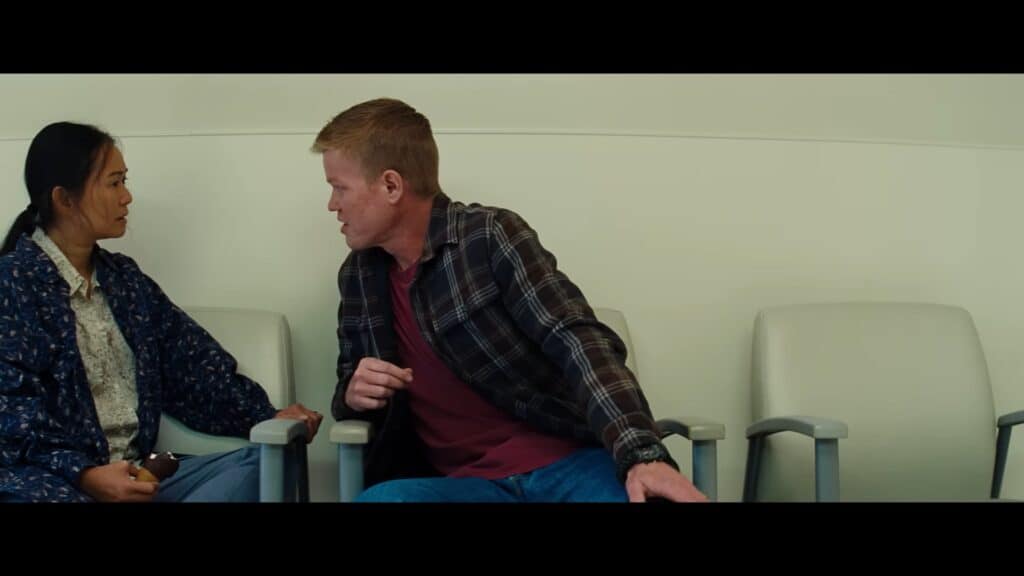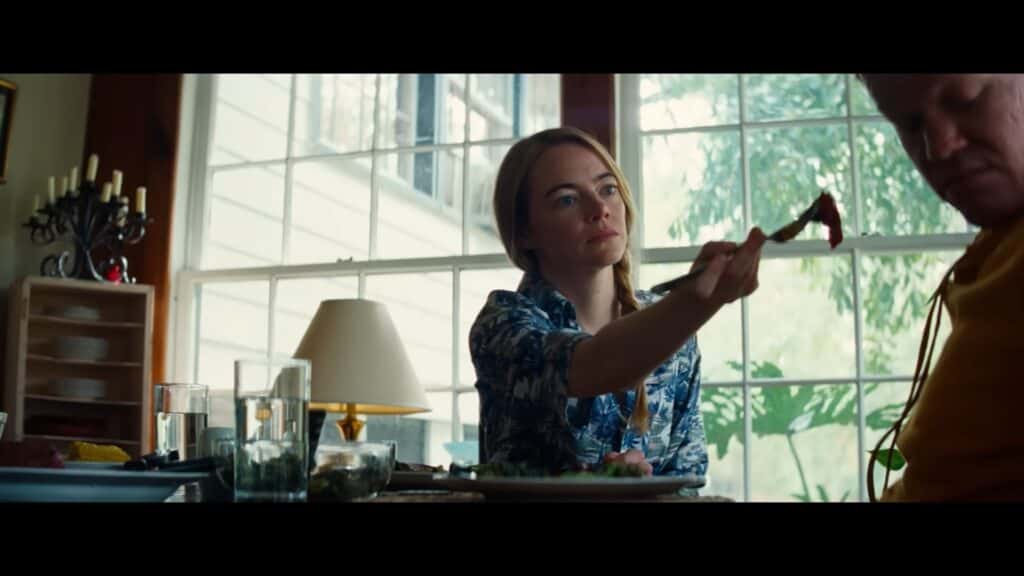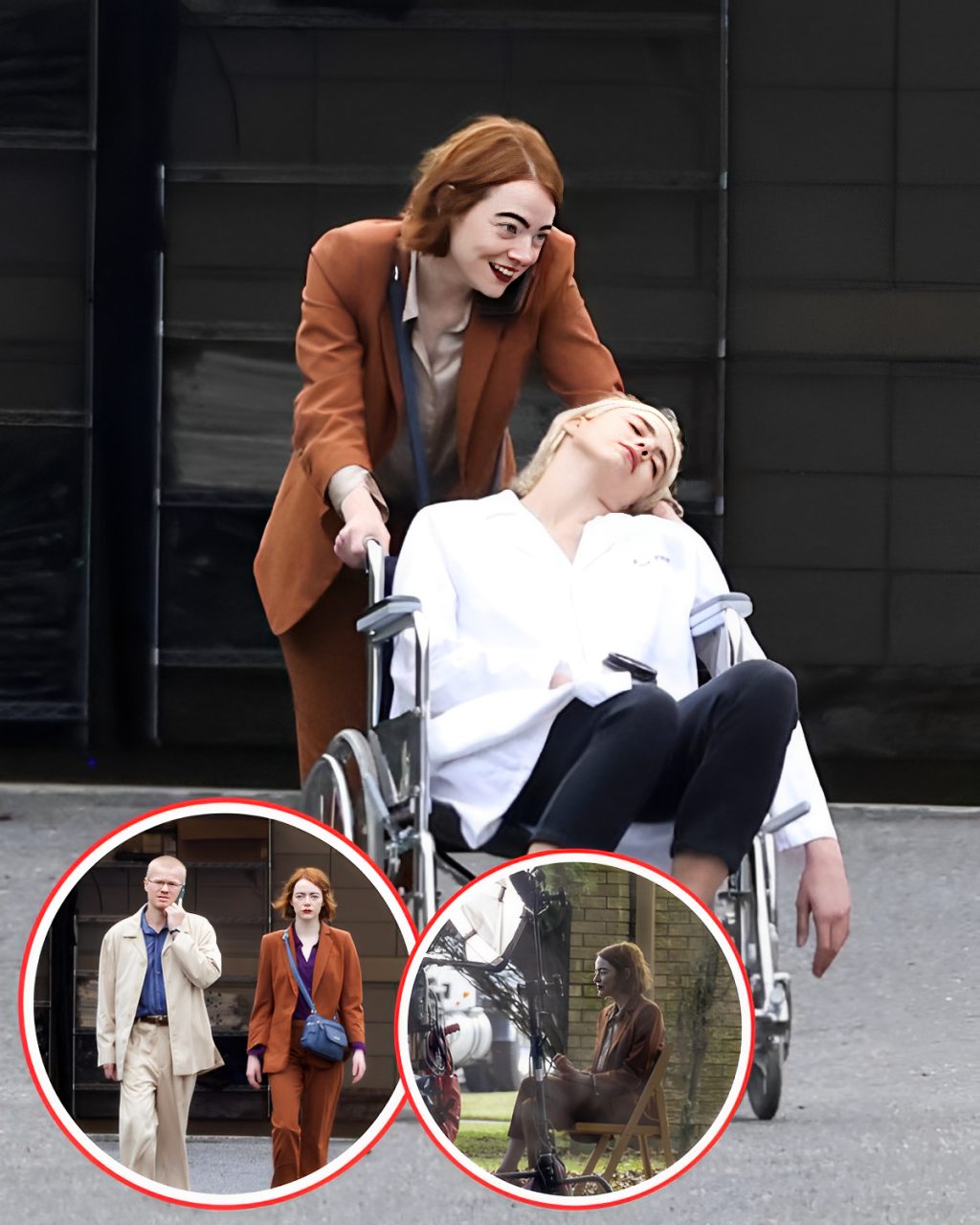Building off of his break into the public eye, Yorgos Lanthimos has graced our cinema screens once again with a characteristically abstract and thought-provoking exploration of the human condition with Kinds of Kindness. Buried beneath the absurdist comedy and abstract imagery is a distinctly human story that dissects the illusions of kindness that we see in day-to-day life, and explores them through the lens of almost comically disconnected stories.

Across all 3 parts of this triptych, Lanthimos asks the question of what kinds of kindness are actually kind. Jesse Plemons’ character in The Death of R.M.F falls victim to an abusive cycle of being love-bombed by an older man – an older man who demands the highest of him in order to stay in his good graces, including causing the death of a seemingly innocent man. The symbol of kindness in this particular short emerges in the material goods of meaningless memorabilia. Lanthimos is sure to draw attention to the absurdity of the situation through the reverence of a completely destroyed tennis racquet as the signifier of the relationship between his and Willem Defoe’s character in Raymond. When this racquet is taken away, it represents the physical removal of this relationship.

Image source: Kinds of Kindness, Yorgos Lanthimos, Searchlight Pictures
I found myself laughing at the absurdity of such an object and the contrasting weight that it carried throughout the film. Lanthimos goes on to use this absurdity to his advantage when exploring just how much this absence impacts Robert. By making this relationship as absurd as possible, and drawing upon the most ridiculous standards, Lanthimos is able to inhabit a space in which he is commenting on how these seemingly unreal situations are still impactful to those who live through them. While we as an audience may not be able to fully comprehend the reality of Robert in this moment, we can safely say that we laugh and observe with curiosity. We have all experienced moments in our lives where we try to help someone and our advice is to just “walk away”; without knowing the truth of a situation, walking away appears to be an easy option. We ask the same of Robert – why does he not walk away in peace when given the opportunity?
The extent of the abuse and resulting dependency of Robert is seen in how he re-enacts the same patterns without Raymond inciting it. Lanthimos draws attention to the presence that abusers can have on the lives of the abused, even when they aren’t in a position of influence any more; their presence is lingering and can be felt. Lanthimos beautifully explores the dependency of abuse victims – an aspect of abuse that is often overlooked by those who observe it. Robert has become dependent on the abusive routine with Raymond and goes above and beyond to reconcile this relationship. This accelerates rapidly to the absurd image of Robert fulfilling his original task and 𝓀𝒾𝓁𝓁ing R.M.F. in the car park of a hospital.

Image source: Kinds of Kindness, Yorgos Lanthimos, Searchlight Pictures
In a last-ditch effort to steal Raymond’s favour away from Rita (Emma Stone), in a fit of jealous rage, he commits an act that he could have very easily avoided. The discomfort of this moment is felt by the audience, through the intentionally unpleasant vocalisation that makes up a significant part of this film’s soundscape. Not dissimilar to his previous work, sound is a tool that Lanthimos uses in order to approach an audience directly, outside of the film’s diegesis. This is used across all three films and is done so in the construction of some real discomfort and tension in how we perceive the characters on screen.

Image source: Kinds of Kindness, Yorgos Lanthimos, Searchlight Pictures
The second of these three stories expands upon this and exposes more of Lanthimos’ very intentional artistic vision. And this most notably emerges in the mirroring of the cast from story to story. Across all three stories, the same core cast is employed, with each inhabiting three different roles. On the surface, this may look to be a neat way of cutting down on auditions and ensuring that there can be ease of production. In reality, this decision serves to highlight the multi-faceted elements of Kinds of Kindness and speaks to the literal myriad of “kinds of kindness” that exist in the world.
In the case of Jesse Plemons, the abused becomes the abuser in the second story: “R.M.F Goes Flying”. Following the story of Daniel – played by Plemons – as he grieves his presumed dead wife, he is shown to ruminate on the past at the cost of his current relationships. Upon Liz’s return, the audience views the rambling speculations of a husband who no longer recognises his wife, and insists that an alien plot must be taking place.
In a mastery of perspective, Lanthimos transforms the innocuous into the suspicious as normal behaviours from Liz are transformed into behaviours that must be scrutinised and examined from all angles. Being postured as an imposter situation, this once again positions the audience from a unique angle; an angle of an abuser deconstructing their victim. Everything becomes a test. Daniel asks Liz to “put on my favourite song” and the entertaining juxtaposition of a loud cutaway hides the distinct tension underneath. In the car, Daniel scowls and glares at his traumatised wife as she tries to readjust to normality, looking for any self-validation to his speculation.

Image source: Kinds of Kindness, Yorgos Lanthimos, Searchlight Pictures
Abuse is a rough area to navigate through any medium and it demands an inherent sense of self-awareness and judgement in order to make sure that it authentically represents the inherent conflict. It also needs to be grounded, not clouded by a comically obvious dynamic that has little to say. Kinds of Kindness threads this needle and manages to create a believable and gut-wrenching story through the absurdist lens. Liz’s recollection of her dreams of a reversed society where dogs are the owners and humans are the pets sounds funny on paper but resonates closely to people who can understand her words. Not dissimilar to the first story, Lanthimos manages to illuminate the horrific security that often emerges in these situations.
Liz talks about how in her dream, she had the rare chance to get a treat, or not risk anything and enjoy a consistent meal. Her conclusion that consistency is “reliable” in spite of their being a better option strikes eerily true to the heart of abusive relationships. While people may struggle, the risk of trying to get something better and the fear of the unknown is a genuine factor that halts progress in many such cases. And this factor is one that fails to be explored by the vast majority.
Daniel’s testing of Liz and her own determination to see their relationship salvaged results in Liz having to harm herself to ‘prove’ her commitment to him, in cutting off a finger. The resulting conflict, in which Daniel berates her for even thinking to do that is another sphere of domestic abuse – gaslighting. The doting housewife is held under scrutiny by Daniel and by the camera as she desperately tries to ‘prove’ herself against the odds. And in a conclusion that defies the narrative standard of ‘satisfaction’ – she 𝓀𝒾𝓁𝓁s herself in pursuit of Daniel’s happiness.

Image source: Kinds of Kindness, Yorgos Lanthimos, Searchlight Pictures
As a gross recontextualisation of a classic love story trope, Daniel’s biases are never eliminated, as he deludes the ‘true’ Liz appearing at the door after the ‘fake’ one 𝓀𝒾𝓁𝓁s herself as a part of his test. In the eyes of the people around her, her pain will never be vindicated or validated, with Daniel driving her to the edge. Liz is shown to be bleeding out on the sofa in a display of grim viscera, and the distinct focus of the camera. Daniel ignores this display and instead embraces the ambiguously real figure at the door, an idealised copy of Liz. The abuser’s delusions are manifest in the eyes of the camera and serve as a final reminder that we as an audience were only allowed to see what the camera allowed us to see, and not the internal journey of Liz.
Any moments we do see of Liz are unambiguously intended to explore the unhealthy dependency that underpins the narratives within Kinds of Kindness, with her own agency being used against her.
In the most supernatural of the three fables, “R.M.F. Eats a Sandwich” juxtaposes the supernatural pursuit of reviving the dead and a spiritual cult against the dullness of the typical American family structure. Emily (again played by Emma Stone) is shown to travel between these two spheres in an awkward conflict between her new life and old life as a mother. In her discreet entrances to her old family home, the weight of motherhood can be felt in the sheer silence of these moments. There is a distinct and intentional blandness to the domestic setting, that is immediately put against the abstract architecture of the cult.
This conflict between two worlds is weaponised against Emily as she finds herself manipulated by her ex-partner into staying the night and falling victim to a violent assault and invasion of her body. In this third story, the kind of kindness being shown is the willingness to let Emily back into the family space, before taking advantage of her vulnerability. Through the absurdist lens of Lanthimos, this act develops into a life-changing incident that sees Emily being punished by the people in the cult and her closest confidants. Having been ‘contaminated’ as a result of the rape by her ex-husband, she is expelled from the cult for being unclean and ‘infected’. The nature of this infection is never made clear through an onscreen diagnosis but is analogous to the shame that can emerge following such a traumatic event. Lanthimos chooses to present this through isolation and alienation in the most extreme of senses in order to help an outside audience sympathise and understand the mindset of many victims.
This alienation develops into bargaining, with a renewed conviction to finish the work that she was already doing for the cult; once again returning to the security of a routine and a mission. Where Emily goes above and beyond to fulfil this supernatural goal, the reality of her commitment is emblematic of a far more dependent personality that once again comments on the difficulty of freedom. We as people do not do well as free people – we need rules and routines to keep us grounded. This is the connective tissue between the three stories. Lanthimos asks us to look back upon ourselves and try to get in touch with ourselves and remind ourselves to live in our own moment, rather than through somebody else.

Image source: Kinds of Kindness, Yorgos Lanthimos, Searchlight Pictures
Emily’s drive and commitment to finish her goal – and desperation to restore her lost honour – results in her literally driving into a wall and destroying everything she had worked for. A final gruesome reminder of the dangers of dependency and the over-reliance of “kindness” from outside sources.
The final shot of the film, as R.M.F. sits enjoying a sandwich at a diner is a brief moment of hope in an otherwise hopeless critique of human reliance. R.M.F. in this singular moment exists as his own person, and he spills ketchup on his shirt. He has returned from death, to eat a sandwich and live his own life. Deeply resonant, and deeply aspirational. Where the protagonists of each of the three stories have been beholden to people around them, this moment is completely singular and outside of any speculative situations.
The comedic elements of Kinds of Kindness can’t be overstated. There is a real mastery in comedic timing and framing across all 3 stories. Yorgos Lanthimos is a master at these cut-aways and comedic moments that land-based purely on these moments. The absurdity of seeing Emily dance outside of the surgery to COBRAH’s BRAND NEW B*TCH and a montage of a dog sipping from a McDonald’s cup might be comedic in their own right, but work alongside the rest of the film to deliver a particularly resonant story that manages to cut to the very core of us as humans and the “Kinds of Kindness” that we can come across.
Sometimes, kindness is a door to much more.





